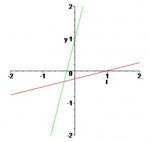… Can you explain how to determine t, if I have to express Y in terms of t?
If Y = f(t), then Y is already expressed in terms of t. Use function f's inverse, to determine t. The inverse function accepts Y as input and outputs t:
t = f
͏͏⁻¹(Y)
If you have a definition for Y = f(t), then swap variable names and solve for Y.
EG:
Y = 4t + 1
Swap variable names
t = 4Y + 1
Solve for Y
Y = (t - 1)/4
The inverse function for f is f
͏͏⁻¹(t) = (t - 1)/4
By swapping names, we can plot both functions on the same coordinate system.
Y = f(
t)
Y = f
͏͏⁻¹(
t)

… Is it possible to use a variable Y as a independent variable and dependent variable ? …
It's okay to
think of Y that way (i.e., as output from f going into f's inverse), but we generally write function notation for each Y, to distinguish them. You could also use subscripts, like Y
f and Y
f⁻¹. In my example, I distinguished them using colors.
Function
f has points (
t,
Y) like (
0,
1) and its inverse function
f͏͏⁻¹ has points (
t,
Y) like (
1,
0)
See how the inputs and outputs are inverted? (0, 1) and (1, 0)
(
t,
Y) can be viewed as (
Y,
t) because
t=
Y and
Y=
t (that is, value
Y used as inverse-function input
t, and inverse output
Y used as f's original value
t).
It's easier, using function notation f(t) and f
͏͏⁻¹(t) as variable symbols instead of Y and Y. This way, you only need remember that symbol t in the inverse function is f's original output.
f(t) = 4t + 1
f
͏͏⁻¹(t) = (t - 1)/4
When you're working with function f, t is the independent variable and it represents values in f's domain. Symbol f(t) represents values in f's range.
When you're working with the inverse function f
͏͏⁻¹(t), t is its independent variable. That is, t represents values from f
͏͏⁻¹'s domain and f
͏͏⁻¹(t) represents values from f
͏͏⁻¹'s range.
In the context of the relationship between a function and its inverse, the t in f
͏͏⁻¹(t) may be viewed as values from f's range.
Points on the graph of function f:
( t, f(t)
)
Points on the graph of function f's inverse:
( f(t), f
͏͏⁻¹(t)
)
You're also free to assign additional symbol names, if you need to, for keeping track of what's going on. Function notation is standard, however.
Let us know, if you still have questions. Please post any specific exercise. :cool:

